B2B SaaS Positioning Canvas: Clarify Positioning with This Tool (Before You Blame Product-Market Fit)
Last updated: September 19th, 2023
The abstract, cerebral nature of positioning as a concept makes it difficult for many companies to approach defining it for their business. We know this because we continue to see companies miss with their SaaS positioning (even ones that have grown to substantial ARR).
Scenarios in which they have a product positioning problem without realizing it plays out in different ways. For example:
- In the early stages: SaaS startups will mistake a positioning problem for a product-market fit problem. They’ll pivot their product or try to serve a new market, causing their sales to suffer, when the problem wasn’t product-market fit to begin with. It was actually poor positioning that led to challenges in communicating what they do and who they’re for to their target audience.
- In later stages: When companies who have grown their business successfully through sales and referrals decide to begin focusing more on inbound marketing and their results are stagnant, they think there’s no way that they could have gotten to where they are with a positioning problem. But when you’ve grown your SaaS business through outbound, you actually can have a positioning problem that reveals itself when you shift your focus to inbound.
And then there are cases when you suspect you have a positioning problem, but fixing it proves challenging and you find yourself in frustrating situations:
- You realize that if your positioning is off, other fundamental areas in your marketing efforts are off, too.
- You’ve tried to revamp your positioning, but there is disagreement among your team that leads to stalling rather than taking action to change it.
- In conversations with prospects, you’ll be talking about a core feature of your product, and your prospects will say they didn’t even know your product did that (making it apparent that they don’t fully understand what you do).
Getting your positioning wrong leads to a whole slew of problems. Your content and messaging across your website and ads will be off. The channels where you advertise to reach new customers will perform poorly, and your costs to acquire customers will be higher.
In this article, we’ll cover the questions we ask prospects (ones you can ask your own team) to gauge their current level of understanding of their company’s positioning. Then we’ll walk you through an example of how we’ve used our SaaS Positioning Canvas to clarify positioning for our client BoardOnTrack.
After reading, you should be able to work through the canvas with your team to gain clarity on your own positioning.
Note: To use this tool, make a copy of the SaaS Positioning Canvas and paste it into your own document to begin filling it out. No need to ask for edit access. (For the canvas to paste properly, go to File > Page Setup > Landscape and adjust the margins from 1” to 0.5” across the board.)
If you think you might have a positioning problem and you’d like to learn more about how we help SaaS companies solve this, you can get your Free Marketing Plan here to talk with our team.
Gauge the Clarity of Your SaaS Positioning by Asking These 3 Questions
To uncover whether or not a prospective client has a positioning problem, we’ll ask 3 questions:
- Who do you help?
- What problems do you solve?
- How does your product work?
The brevity and crispness with which they answer these questions is a telltale sign of whether or not positioning is clear in their organization. You can use these questions to diagnose how well you understand the positioning of your own SaaS product.
A couple things to note:
- When the answer to the first question is too broad, it’s likely you have a positioning problem.
- For the second question, often people’s instinct is to jump straight to describing their solution. But the key is to focus on describing the problem as clearly as possible.
Something to try: Send out a form to stakeholders in different areas of your organization. Ask them to answer these three questions and see how their answers match up with yours to get a sense of how clear you are with your own positioning.
Now let’s walk through an example of filling out the canvas so you can see how it works.
The SaaS Positioning Canvas: 7 Steps to Clearly Define Your Positioning
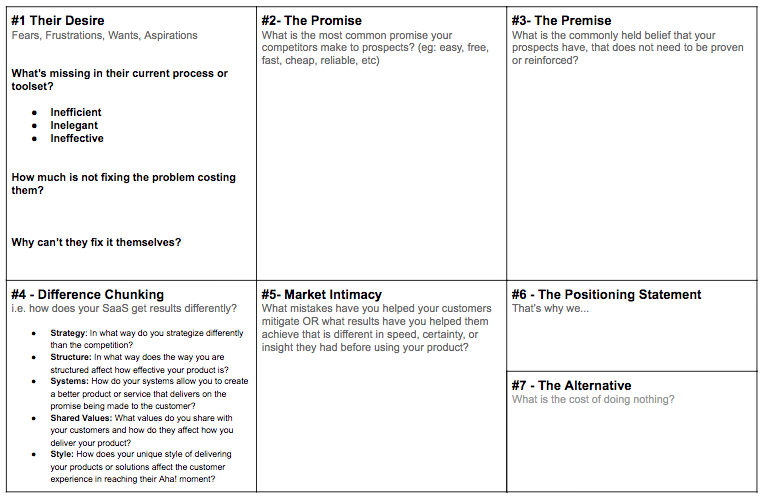
Positioning is often mistaken for things like a tagline, a slogan, or a unique value proposition. But these things aren’t positioning, they come from or are informed by positioning.
Our belief is that good positioning is assembled, just like good copy. And you can use this canvas to create the building blocks.
We recently filled this out with our client BoardOnTrack, who offers a school board management platform for charter schools. We’ll use their canvas as an example throughout.
The first thing we want to understand is: “for your ideal customers, what are their fears, frustrations, wants, and aspirations?”
This brings us to step 1.
Step 1: Their Desire (Fears, Frustrations, Wants, Aspirations)
In this first step, we seek to answer the following questions:
What’s missing in their current process or toolset?
The truth about SaaS products is that, generally, you’re providing a way to accomplish something that could usually be done in Excel or Google Docs, but in a fashion that is more elegant, efficient, or effective.
So we answer this first question through the lens of these three characteristics.
In the case of BoardOnTrack, we came up with the following:
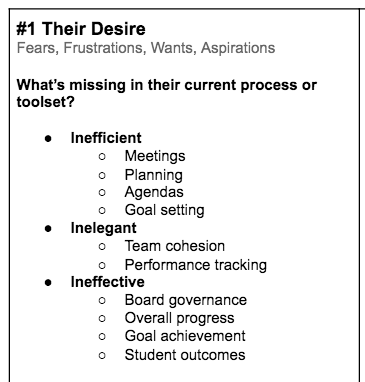
Notice: These are very specific pain points that their target market can easily relate to. And they speak directly to the fears, frustrations, wants, and aspirations of charter school boards.
You don’t need to overcomplicate this. Simple bullets are sufficient.
How much is not fixing the problem costing them?

This is the cost of not fixing the problem in the present state. For charter school boards operating without a solution to their inefficiencies, things like being stuck reacting to problems instead of preventing them and dealing with unproductive board meetings are visceral pain points they can relate to.
Bringing to light the true cost of not fixing their problem creates tension for your prospects — leading them to face the downside of their current situation. When you create this tension, you leave them with two choices: relieve the tension by taking action and investing in your solution, or ignore the problem and deal with the costs.
Why can’t they fix it themselves?
To build even further upon that tension, you can combine the cost of not fixing the problem with a relatable explanation of why it’s been so hard to fix.
For BoardOnTrack, it was:
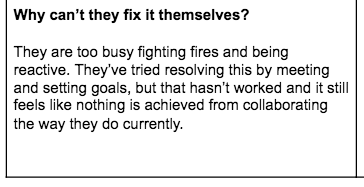
Together, these three questions help you be specific and define the deep desires of your prospects that will help you communicate with them in a way that resonates.
Step 2: The Promise
For step 2, you’ll go to your top 5 competitors’ home pages, look at what their taglines and value propositions are, and write them down.
And then you’ll try to describe your promise in ultra-layman’s terms. For BoardOnTrack, the promise we came up with was:
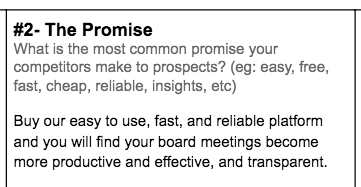
Notice: This is another instance in which you don’t need to overcomplicate things. It’s sufficient to simply choose what you think are the most compelling characteristics of your product (eg. easy, fast, reliable), and connect them to the main benefits (eg. become more productive, effective, and transparent).
Step 3: The Premise
In step 3, we seek to answer: “What is a commonly held belief that your prospects have, that does not need to be proven or reinforced?”
The function of this question is to take into consideration that humans are skeptical, and usually prospects will view your claims with a dose of skepticism. So why not make a claim that they already commonly accept or believe?
For BoardOnTrack, the premise was:
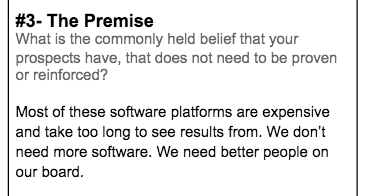
For them, they agreed that this statement is one that many of their customers could nod their heads along to. And premises like this can be used to create a bond with your prospects.
Step 4: Difference Chunking
In step 4, we seek to answer: “How does your company get results differently than anybody else?”
This is not meant to be a slick thing. It’s actually a process of talking to product owners and engineers to say, how do you do it differently?
We’re looking for differences that are rooted in fact, and we use the following guiding questions:
- Strategy: In what ways do you strategize differently than your competitors?
- Structure: How does the structure of your business relate to how effective your product is?
- Systems: How do your systems allow you to create a better product or service that delivers on the promise being made to the customer?
- Shared Values: What values do you share with your customers and how do they affect how you deliver your product?
- Style: How does your unique style of delivering your products or solutions affect the customer experience in reaching their “Aha!” moments?
For BoardOnTrack, we came up with the following:
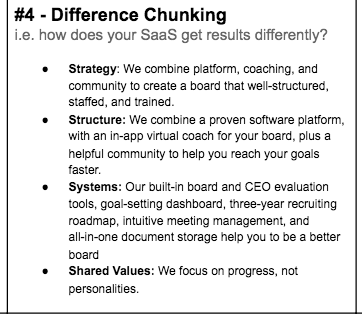
Identifying your brand and product differentiators in this way is a key element of positioning yourself in a competitive market.
Step 5: Market Intimacy
In step 5, we seek to answer: “What mistakes have you helped your customers mitigate? Or what has your product helped them achieve that has resulted in increased speed, certainty, or insight?”
For the first question, if you can point out the common mistakes that customers make before using your product, it shows that you have expertise or authority in your niche.
And for the second question, we think the desire for speed, certainty, and insight are typically the primary reasons why companies invest in a new product — so showing results that speak to these can elevate your market positioning.
With BoardOnTrack, we came up with:
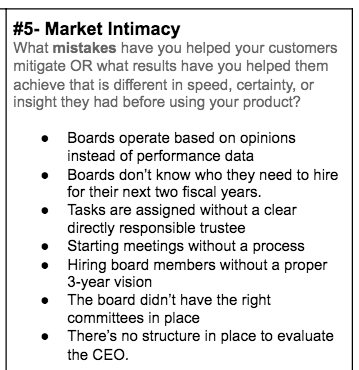
Once you’ve created this list, the next step is to create your positioning statement.
Step 6: The Positioning Statement
In step 6, we seek to answer: “That’s why we…”
Using this list as a bridge, you can move into writing your positioning statement to answer, “That’s why we…”.
In the case of BoardOnTrack, it was:
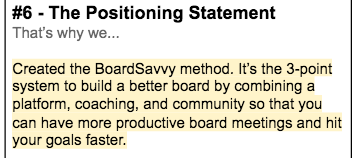
Your positioning statement should be no longer than 2-3 sentences. Your goal is to use the prior building blocks to sum up what you do and how you’re different in a concise way.
And finally, you describe the cost of doing nothing.
Step 7: The Alternative
In step 7, we seek to answer: “What is the cost of doing nothing?”
This step is similar to the cost of not fixing their problem that you listed in step 1. The difference is, if the cost of not fixing their problem relates to the present state, the cost of doing nothing is the current cost compounded by the number of months or years into the future that they don’t solve their problem.
BoardOnTrack brings it home with:
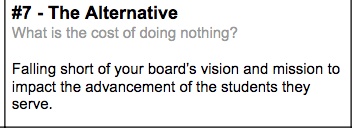
For charter school boards, who are typically very passionate about serving students, facing the cost of limiting their impact on student advancement is the type of message that can move prospects forward towards investing in a solution.
Here was the final result for BoardOnTrack:
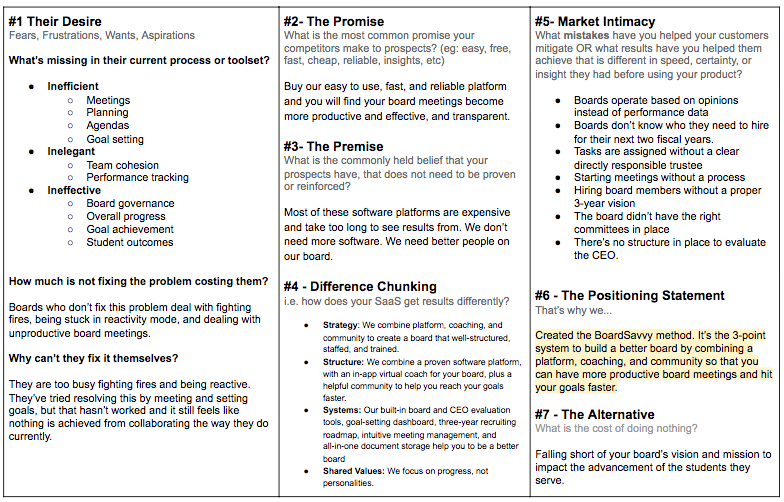
Conclusion
Once you’ve completed the entire canvas, you’re left with a concise document that any member of your organization can reference at any time, allowing everyone to be clear on what makes you, you.
The next step, of course, is to integrate your canvas into marketing and sales activities to better communicate with customers and separate yourself from the competition.
We hope this canvas will help you and your organization find more clarity on your positioning. If you’d like to learn more about how we help SaaS companies implement their canvas by integrating it into their marketing activities, get your Free Marketing Plan here.
What you should do now
Whenever you’re ready…here are 4 ways we can help you grow your B2B software or technology business:
- Claim your Free Marketing Plan. If you’d like to work with us to turn your website into your best demo and trial acquisition platform, claim your FREE Marketing Plan. One of our growth experts will understand your current demand generation situation, and then suggest practical digital marketing strategies to hit your pipeline targets with certainty and predictability.
- If you’d like to learn the exact demand strategies we use for free, go to our blog or visit our resources section, where you can download guides, calculators, and templates we use for our most successful clients.
- If you’d like to work with other experts on our team or learn why we have off the charts team member satisfaction score, then see our Careers page.
- If you know another marketer who’d enjoy reading this page, share it with them via email, Linkedin, Twitter, or Facebook.